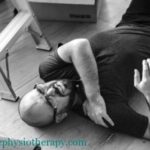Hoffa’s Syndrome
The knee fat pad, or infra-patellar fat pad, is a soft tissue structure on either side of the patella just below and under the patella and between the knee bones. Because the fat pad is highly innervated it is considered one of the most sensitive structures in the knee.
The fat pad easily gets irritated and can be a great source of knee pain and discomfort. Since the fat sits just below the knee cap, if there are problems with the kneecap alignment it can cause pinching or ‘Impingement’ on the fat pad. Fat pad syndrome is also known as Hoffa’s Syndrome.
Causes of Fat Pad Syndrome
- Injury/trauma to the front of the knee e.g. fall, motor vehicle accident, football tackle, etc
- Tightness in quadriceps muscle
- Genu Recurvatum (excessive extension of the knee)
- Forwardly tilted pelvis in obese population
- Osteoarthritis in the knee predisposes to fat pad syndrome
- Hardened fat pad due to scarring and subsequent fibrosis.
Symptoms of Fat Pad Syndrome
Fat Pad Impingement, also called Hoffa’s Syndrome includes the following symptoms :
- Pain in the front of the knee
- Swelling below and around the knee
- Pain while straightening the knee
- Pain with prolonged walking, squatting, and kicking activities
- Pain with wearing high heels
These symptoms can also be characteristic of several other knee conditions including Patellar Tendonitis and Patellofemoral Pain Syndrome.
So, we recommend you consult PAIN FREE PHYSIOTHERAPY CLINIC for a thorough assessment and proper diagnosis.
Diagnosis
On examination, the physiotherapist will observe the signs and symptoms mentioned above. A clinical test called Hoffa’s test should be performed which involves moving the patella after contracting quadriceps muscles helps in diagnosing the problem.
Treatment of Fat Pad Syndrome
Physiotherapy treatment will hasten the recovery process.
The Physiotherapy treatment will aim to:
- Reduce pain and inflammation. This may entail usage of Electrotherapy, cryotherapy, therapeutic taping, dry needling, and Gait Training.
- Normalize joint and muscle range of motion.
- Strengthen knee and leg muscles.
- Optimize patellofemoral (kneecap) alignment.
- Improve proprioception, agility, dynamic balance, landing technique, and function e.g. walking, running, squatting, hopping, and landing.
In resistant cases of fat pad syndrome, surgical treatment may be undertaken. Arthroscopic Debridement or partial removal of the fat pad is done.
Prevention
By optimizing the strength and flexibility of the muscles around the knee, hip and ankle can prevent and avoid reoccurrence of the condition. The physiotherapist is the most suitable person to consult for an appropriate exercise program.
By avoiding potentially aggravating activities such as kneeling, squatting, and kicking for prolonged periods if one has suffered the problem earlier.
For females, it is best to avoid or limit walking in high heels.





